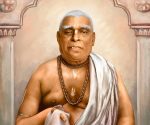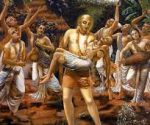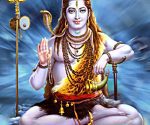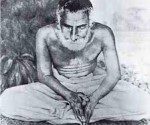What is Pure Bhakti?
by Sri Srimad Bhaktivedanta Narayana Maharaja
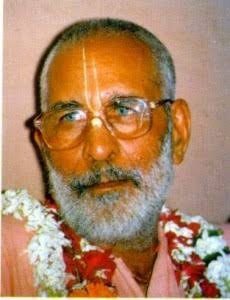 Sri Jagannatha Puri:
Sri Jagannatha Puri:October 9, 2001 (pm)
Yesterday I explained in brief how Sri Caitanya Mahaprabhu, the endless ocean of rasa, inspired all truths in the cloud-like Srila Raya Ramananda. Then, He in turn heard and realized all these truths from Srila Raya Ramananda. He attained vijnana, realization of those truths. Now, if you want to enter deeply in the dialogue of Srila Raya Ramananda, Raya Ramananda Samvad, you will have to know some primary things. Those who want to really deeply enter Raya Ramananda Samvad and realize it, should be sincere. They should be very sincere. They should know what is perfect bhakti, that is, svarupa-siddha-bhakti, and they should know what is sanga-siddha-bhakti, aropa-siddha-bhakti, and karma-jnana-misra-bhakti. The definition of pure svarupa-siddha-bhakti is the barometer of bhakti, and from it we can know whether or not one is performing bhakti and what class of bhakti he is in. Otherwise we cannot.
First we should try to explain what is bhakti.
[Sripad Madhava Maharaja translating Srila Narayana Maharaja’s Hindi:] Srila Maharaja just explained that prior to Sri Caitanya Mahaprabhu, so many acaryas came to this world, like Sandilya Rsi, Parasara Muni, Narada Rsi, Vyasa, etc. Sandilya Rsi has defined bhakti in his books. He explained that if one has great attachment and a sense of ‘mineness’ for God, that is called bhakti, but he did not clarify who is God — Lord Krsna, Lord Ramacandra, or any Visnu incarnation. After that, our Purvacarya [previous acarya] Sri Narada Rsi has defined bhakti in his Narada-pancaratra:
sarvopadhi-vinirmuktam
tat-paratvena nirmalam
hrsikena hrsikesa-
sevanam bhaktir ucyate
“Bhakti, or devotional service, means engaging all our senses in the service of the Lord, the Supreme Personality of Godhead, the master of all the senses. When the spirit soul renders service unto the Supreme, there are two side effects. One is freed from all material designations, and one’s senses are purified simply by being employed in the service of the Lord.” (Cc. Madhya 19.170)
Sarvopadhi-vinirmuktam. You have to be free from all material designations, such as, “I am a king,” “I am a subject,” “I am the husband of this lady,” or “I am a wife.” Tat-paratvena nirmalam. There are two principles in this world. One is tat-padartha and another tam-padartha. Tat means Bhagavan, and tam means the jiva. Tat-paratvena. You have to be absorbed completely in the bhajana of Bhagavan, who sad-vastu, the reality. Then your heart will be pure. Tat-paratvena nirmalam / hrsikena hrsikesa-sevanam. After that, being pure hearted, you should serve God with all of your senses. Ambarisa Maharaja has shown us the light of how to serve God with all one’s senses. If you do that, then it will be bhakti.
In Srimad Bhagavatam we have also seen the definition of bhakti:
sa vai pumsam paro dharmo
yato bhaktir adhoksaje
ahaituky apratihata
yayatma suprasidati
[“The supreme occupation (dharma) for all humanity is that by which men can attain to loving devotional service unto the transcendent Lord. Such devotional service must be unmotivated and uninterrupted to completely satisfy the self.” (Srimad Bhagavatam 1.2.6)]
In another sloka it is stated:
laksanam hi bhakti-yogasya
nirgunasya hy udahrtam
ahaituky avyavahita
ya bhaktih purusottame
[“The manifestation of unadulterated devotional service is exhibited when one’s mind is at once attracted to hearing the transcendental name and qualities of the Supreme Personality of Godhead, who is residing in everyone’s heart. Just as the water of the Ganges flows naturally down towards the ocean, such devotional ecstasy, uninterrupted by any material condition, flows towards the Supreme Lord.” (Srimad Bhagavatam 3.29.12)]
Sa vai pumsam paro dharmo. This is the best religion for living entities. Here pumsam means all living entities. Ahaituky apratihata / yayatma suprasidati. One has to serve continuously. Continuous means like an unbroken stream of honey. If you pour honey from a jar, its flow is an unbroken stream from top to bottom. Similarly, you’ll have to do bhakti continuously. Here atma means that both the soul and Supersoul will be pleased. If the Supersoul is pleased, then the soul will be automatically pleased.
After all, by the causeless mercy of Sri Caitanya Mahaprabhu, Srila Rupa Gosvami has defined bhakti in his Bhakti-rasamrta-sindhu. Hearing that definition, all the associates of Sri Caitanya Mahaprabhu became overjoyed. Raising his two arms, Srila Haridasa Thakura began to dance. Now Srila Maharaja is going to explain Srila Rupa Gosvami’s definition.
[Srila Narayana Maharaja again spoke in Hindi and Sripad Ramacandra dasa Adhikari translated his words:] Srila Maharaja is explaining here that in order to enable ourselves to enter Raya Ramananda and Sri Mahaprabhu Samvad, first we have to know what is bhakti. Srila Maharaja has taken the definition bhakti from Srila Rupa Gosvami. Srila Rupa Gosvami’s definition includes all the other definitions of the previous acaryas. Anyabhilasita sunyam jnana-karmady-anavrtam, anukulyena krsnanu-silanam bhakti uttama.
What is the svarupa-laksana, intrinsic nature, of bhakti? It is anukulyena krsnanu-silanam, constant endeavors performed to please Krsna. At the same time, we should know what should be avoided. That is called the tatastha-laksana, marjinal characteristic, of bhakti. The tatastha-laksana is anyabhilasita sunyam jnana-karmady-anavrtam.
[Sripad Aranya Maharaja (translating Srila Narayana Maharaja’s Hindi):] Srila Maharaja has explained what is anusilanam, nivrtti-mulaka and pravrtti-mulaka, making constant endeavors to reject what is unfavorable and accept what is favorable for bhakti.
When sadhana is mature then:
‘mane’ nija-siddha-deha kariya bhavana
ratri-dine kare vraje krsnera sevana
“There are two processes by which one may execute this raganuga bhakti – external and internal. When self-realized, the advanced devotee externally remains like a neophyte and executes all the sastric injunctions, especially those concerning hearing and chanting. But within his mind, in his original, purified, self-realized position, he serves Krsna in Vrndavana in his particular way. He serves Krsna twenty-four hours a day, all day and night.” (Cc. Madhya 22.157)
Internal service means serving by bhava, as Srila Rupa Gosvami and Srila Raghunatha dasa Gosvami have done. In his definition, Srila Rupa Gosvamipad has not stopped by giving the word krsnanusilanam. He also used another word, and that is anukulyena. What is the necessity of this word? It means the absence of pratikula-bhava, an antagonistic mood towards Krsna.
Some people think that anukulyena means ‘pleasing to Krsna’, but this is not the meaning. Anusilanam means endeavors which are uninterrupted, going on without any brake, like a flow of honey. Anu also means in the anugatya, under the guidance of, rasika-bhagavat-vaisnavas. Srila Maharaja said, “Don’t be like Rupa Kaviraja. He was not following his seniors and superiors. He was not under their guidance; rather he independently made his own new path and process. That is not anusilanam.
How should anusilanam be performed? Anukulyena. This word does not mean giving Krsna pleasure. Anukulyena means the absence of pratikula-bhava, a mood which is unfavorable.
Why is it necessary to understand this? Srila Maharaja explained that if we say that the endeavors simply give Krsna happiness, then two types of faults will spring up. One kind of fault is called avyapti-dosa, and the other is called ativyapti. This should be understood very clearly. The word vyapti means covering. The definition of bhakti should cover or include everything that is bhakti. If the definition is too narrow, it may exclude some things that are actually bhakti, and that is called avyapti-dosa, the fault of under-extension of the definition. The other fault is called ativyapti-dosa. That means when the definition is too broad, too loose, then it covers everything which is bhakti but it extends further to cover those things which are not bhakti. This is the fault of over-extension of the definition.
Srila Maharaja then gave an example to illustrate avyapti-dosa and ativyapti-dosa. The first is ativyapti-dosa, the fault of a definition that over-extends itself to include that which is not bhakti. The example is the wrestlers Canura and Mustika. When Krsna and Balarama came to the wrestling arena of Kamsa, Canura, Mustika, Kosala, and the other wrestlers were ready to fight with Krsna. They challenged Him and inspired His mind with vira-rasa, a mood of heroism. While wrestling, Krsna experienced so much happiness. The wrestlers’ fighting was pleasing to Krsna, but it was not bhakti at all. The wrestlers had pratikula-bhava, a mood that was against Krsna. They were not concerned with Krsna’s happiness. They wanted to kill Him. They were not concerned with His auspiciousness and welfare. They did not think He should be benefited and happy in His life. In this way, even though the activity of fighting was pleasing to Krsna and gave Him happiness, the wrestlers themselves had pratikula-bhava.
Anukula means ‘pratikula-bhava-rohita’. When pratikula-bhava is absent, it is called anukulyena. If one says, therefore, that anukulyena krsnanusilanam means endeavors which please Krsna, the definition will then be extended to include Canura and Mustika, who had no bhakti at all. This would be the fault of ativyapti-dosa, over-extension of definition.
The second type of fault in definition is called avyapti-dosa. Mother Yasoda was feeding Krsna her breast-milk, and Krsna was very pleased by this. However, when she saw that the milk on the stove was boiling over, although Krsna wanted to continue drinking, Mother Yasoda put Him down with one hand and left Him, and went to take care of the milk. Krsna was not pleased by this. He bit His lips. He became angry and frustrated, and tears came from His eyes. He was so angry that He took a vessel of yogurt and broke it.
It seems, then, that this endeavor, this krsnanusilanam that was preformed by Yasoda Maiya, was not pleasing to Krsna. Therefore, if we take the word anukulyena to mean pleasing to Krsna, Mother Yasoda’s activity will not be included within uttama-bhakti. Saying this would be a fault of avyapti-dosa, under-extension of the definition.
Actually, all of Mother Yasoda’s activities were completely and fully bhakti. She had no idea of Krsna’s Bhagavata, that He is Parabrahma. She was only thinking how He will be benefited and how His life will be auspicious. She was thinking, “If the milk will boil over then what would happen? By my breast-milk I cannot make sandesh, I cannot make khira, and I cannot make so many other preparations. If I don’t feed these to Krsna, He will not be happy.” Therefore, putting Krsna down, she took care of the milk. She had so much love for Krsna that sometimes it seemed that she has more love for tadiya-vastu, the substances in connection with Krsna, than for Krsna Himself. Why? This was because these things gave happiness to Krsna and made His life auspicious and successful.
Srila Maharaja gave another example: If Krsna will tear His cloth or lose His ornaments, Mother Yasoda will twist His ear and give Him a slap. She will show Him a stick and threaten, “O, I will beat you.” And when she does this, Krsna becomes upset. He is not pleased with this, so why is she doing it? She thinks, “Krsna should grow up to be well behaved and responsible, and in this way His future will be auspicious and happy. Her activity is really full bhakti, anukulyena, because it’s pratikulya-rohita. The endeavor may be pleasing to Krsna or it may not be pleasing to Krsna, but somehow it is for His benefit. Srila Gurudeva raised a point. If someone has this mood, anukulyena, meaning they are devoid of pratikula-bhava, will they be doing bhakti? No, it will still not be bhakti. It will be bhakti when there is both anukulyena and krsnanusilinam.
[Srila Narayana Maharaja:] I gave an example of Krsna in boyhood with Baladeva, Sudama, Madhumangala, and other cowherd friends.
[Sripad Aranya Maharaja:] Srila Maharaja gave the example of Brahmanda Ghata. When Krsna was a small child, his brother Baladeva and so many friends told Yasoda Maiya that Krsna was eating earth. Yasoda Maiya became very concerned. If a baby eats earth he will become sick. She therefore came and asked, “Have You eaten earth?”
Krsna said, “O mother, I have not eaten any earth.”
“Baladeva and all Your friends are saying that You have done so. Show me Your mouth.”
Krsna opened His mouth and Mother Yasoda looked inside. She not only saw earth, but all the planets and all the universes inside the mouth of Krsna. Still, Mother Yasoda had no idea of that Krsna is the Supreme Lord. She was only thinking, “He is my child. If He is pleased or not pleased by what I do, this is not important. Krsna must grow up to be happy and auspicious in His life.”
Srila Maharaja explained that if only this mood of pratikula-rohita is there, it will still not be bhakti. Both elements must be there; that is, anukulyena and also krsnanusilanam. When both combine, this will be uttama-bhakti – as long as there is no anyabhilasita sunyam jnana-karmady-anavrtam. Note that the fault of ativyapti and avyapti is the fault of definition, not the fault of Mother Yasoda or Canura and Mustika.
Srila Maharaja has explained the meaning of anukulyena, but this has been used next to the word anusilanam. When both ideas are together, then they reveal to us the svarupa-laksana, natural characteristic, of bhakti. Alone, neither one nor the other will suffice. If we only take the word anukulyena, which means pratikula-rohita, devoid of a mood which is antagonistic to Krsna, it will not be bhakti. We can see this in the example of an earthen pot. The pot has no mood against Krsna, but we cannot say it is doing any bhakti because it is not doing any anusilinam. It is not performing any endeavor at all – no seva. It cannot be doing bhakti.
Srila Maharaja explained that there are devotees in santa-rasa, the mood of neutrality. If someone in santa-rasa sees a person criticize and insult Krsna, they will do nothing. They will not say anything and they will not complain. They will remain silent. Those in santa-rasa will not feel hurt by those words, and therefore they have not much anusilinam. Jnani-bhaktas are influenced by santa-rasa, and Bhismadeva is an example. In the battle of Kuruksetra, Bhisma took his bow, fired arrows at Krsna, cut His body and made it bleed.
[Srila Maharaja:] Why did he do so? He was thinking that Krsna is the Supreme Personality of Godhead, and He therefore cannot be injured.
[Sripad Aranya Maharaja (translating):] Krsna has a transcendental body. It cannot be divided. He is the Absolute Truth and therefore He will not feel any pain. He cannot be cut, He cannot be killed, and so there is no harm. Is Bhismadeva a bhakta? Or, is he a non-devotee because he is doing this to Krsna? No, he is not a non-devotee. Even though he was shooting arrows at Krsna, he had no pratikula-bhava. He has no mood against Krsna. His jnana, knowledge of Krsna’s Godhood, allowed him to think that Krsna was not hurt by his actions.
[Srila Maharaja:] Bhisma Pitamaha did not actually fight with Krsna, nor did he shoot at Him. Who did? A demon inside him. [Sripad Aranya Maharaja]: Srila Jiva Gosvamipada explained in his commentary that a demon entered Bhismadeva and it was he who was shooting Krsna. We therefore see that anukulyena was there. Bhismadeva was pratikula-bhava-rohita, but he was not doing any seva for Krsna. So when there is anukulyena, a favorable mood towards Krsna, along with anusilanam, the cultivation of all endeavors of the body, mind, words, and moods, which is continuous and under the guidance of pure devotees, this is called the svarupa-laksana of uttama-bhakti.
Srila Maharaja then said that we’ll also have to know the extrinsic or marginal characteristic of bhakti, which is called tatastha-laksana. The tatastha-laksana of uttama-bhakti has been defined in the line anyabhilasita sunyam jnana-karmady-anavrtam.
Anyabhilasita sunyam. First of all, the general idea means there is no selfishness. The devotee does not serve Krsna to get anything in return. He is not doing anusilanam for his own happiness or with any expectations. But here it is not stated ‘anyabhilas-sunyam’, completely devoid of all other desires. The verse is saying ‘anyabhilasita sunyam’. This suffix ‘sita’ indicates that one should be devoid of all desires except for the service of Krsna in one’s svabhava, his natural position. If one is sitting down chanting and everything is peaceful, then in his nature he has no desire other than to serve Krsna. If a calamity or crisis or great danger will come, if someone comes to kill or beat that person, then at that time his regular nature, his svabhava, becomes transformed, and at that time he may call out, “O Krsna, save me.” In this situation the devotee is asking Krsna for something for himself, but this mood is not in him. It is not in his svabhava in ordinary circumstances. Therefore, by the word anyabhilasita, this suffix ‘sita’ has made a concession to include this devotee in the definition of uttama-bhakti.
Srila Maharaja then explained the word anyabhilas. This is the desire for worship and fame and so on. One should be devoid of all these things, and he should desire nothing for himself. ‘Sita’ is given to indicate that these things are not present in one’s svabhava. Srila Maharaja gave some examples to illustrate this:
The first example is Draupadi. Draupadi served Krsna, and she didn’t want anything in return. Yet, we see that when Dusasana came to take away her clothes, at that time she called out, “He Govinda! O Govinda, please save me!” Apparently she was asking for something for herself. Did this mean that her activity was not pure bhakti? No, because in her svabhava, in her ordinary condition, she would never ask Krsna for anything. Only at this time of crisis or calamity was she calling. Therefore her action is included in the definition of uttama-bhakti.
On the other hand, let us see the example of Dhruva Maharaja. Dhruva Maharaja was not in any predicament or dangerous situation, but he was standing and chanting his mantra, thinking, “I want a kingdom greater than that of my grandfather.” Dhruva is anyabhilas. His desire other than the satisfaction of Krsna was in his svabhava, and therefore he cannot be included in the category of an uttama-bhakta.
Srila Maharaja then came to the topic of jnana-karmady-anavrtam. Srila Rupa Gosvamipad never said ‘jnana-karmady-sunyam,’ to be devoid of karma and jnana. He said ‘jnana-karmady-anavrtam.’ Your karma and your jnana, the knowledge that you have and the activities that you perform, should not cover your bhakti. No one can become free from jnana and karma. Eating is a karma, breathing is a karma, going here and there – these are all karmas. We cannot be free from these, and we will also have to perform some duties in society. They should be done in such a way, however, that they do not cover bhakti.
Srila Maharaja explained that you cannot be without jnana, and especially in the beginning, jnana is very good. We will have to have some knowledge of what is bhakti-tattva and so on. By tattva-jnana, by knowing siddhanta, the mind will be steady, and with a steady mind one can become absorbed. Some jnana is good, therefore. It will not cover bhakti. On the other hand, impersonal jnana will cover bhakti.
Srila Maharaja gave the following example: If someone dies, then according to karma-kanda sastra, the relatives will have to do some sraddha. They will have to do a ceremony for their deceased relative. They will have to make some oblations. Why? Being in this world, if anyone will commit sinful activities, knowingly or unknowingly, there will be a reaction and they will have to go to hell and suffer. Their descendents do this sraddha ceremony, and by this they offer prasadam to their deceased relatives who become free from suffering.
If someone is a Vaisnava and chanting harinama throughout their whole life, is there any necessity to do any sraddha for them? What necessity is there? Can they go to hell? Will they be in a suffering condition? No, they will either be in a better position or they may even go back home, back to Godhead. There is no need to do sraddha for Vaisnavas. Still, Vaisnavas may do sraddha for their deceased relatives. Why? When they perform this function they will invite so many sadhus along with all their relatives. There will be harinama sankirtana, classes on hari-katha, and prasadam distributed to everyone. Everyone will get benefit. At the same time, the Vaisnavas don’t have a belief that, “If I do this sraddha my bhakti will increase.”
If someone has the faith that, “By performing sraddha my bhakti will be increased,” or if someone has a faith that, “By not doing sraddha this will be dangerous and detrimental to my devotional service,” then this karma will be avrta. It will cover bhakti. When the karmas and duties of this world are performed without faith that they will either be favorable or unfavorable to bhakti, and the performer engages in a detached way, such activities can be made favorable for preaching or for bhakti. That karma does not cover bhakti and it is thus permitted.




